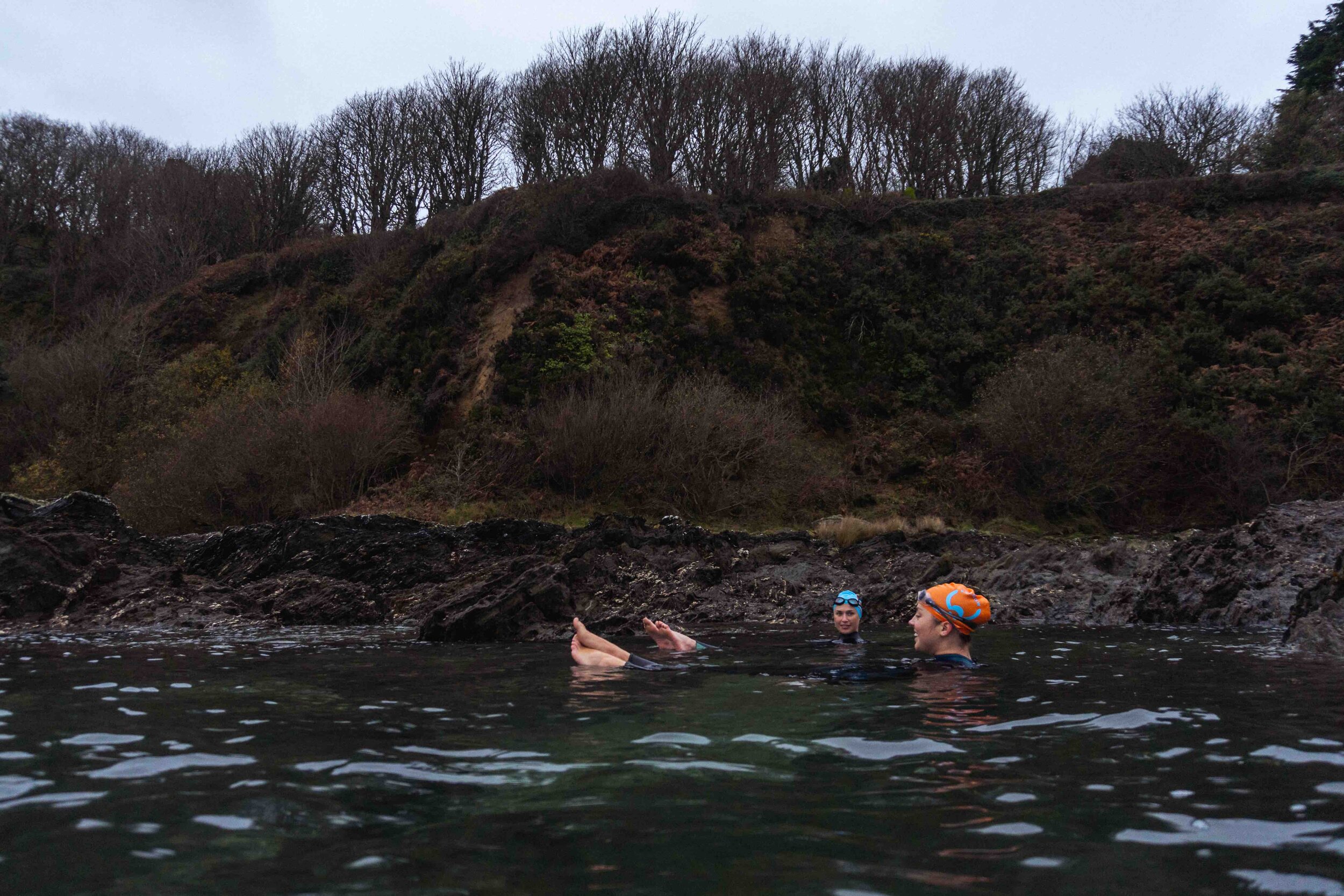Sea Motion Sickness whilst Swimming
Credit: Ross Taylor
We’ve had some questions about sea motion sickness during this winter season. Whilst traditionally associated with boats, it’s possible to become ‘sea sick’ whilst swimming too. More of a challenge for open water swimmers than regular dippers, it can be an unpleasant and disorienting experience. We asked our friend and swimming coach Clare Lewis to shed some light on how and why some swimmers experience sea sickness and what they can do to prevent it.
Words by Clare Lewis, Open Water Swimming Coach at Sureswim Kernow
Motion sickness while swimming can be experienced when swimming in the pool but more commonly in open water, especially the sea. The sea is prone to many more variables of movement and on days where water is choppy or there is swell, there is an increased likelihood of it being experienced by swimmers. Motion sickness is pretty unpleasant and can lead to feelings of nausea, dizziness, headache, disorientation, weakness and vomiting.
Who gets seasick?
I am very fortunate in barely ever having experienced motion sickness. I've sailed a few oceans in my time and hailing from the Isles of Scilly, I am familiar with travelling on the flat bottomed ferry the Scillonian (AKA ‘Chunderlonian’) which is notorious for travellers leaving the contents of their stomachs aboard. However, a few of our Sureswim community have had their flow interrupted by this unfortunate condition and having been asked about the whys and wherefores I did a little research into it.
25-30% of the population are estimated to be affected by motion sickness. You are usually more prone to other kinds if you experience one. For example, if you tend to get car or plane sickness then you are more likely to get sea sick. There is also an increased chance if you are under 15 years of age, a woman or a migraine sufferer.
We’ve been getting open water swimming lessons with Clare (left) since the end of summer 2020.
What causes sea motion sickness whilst swimming?
You can be affected with motion sickness when your senses are in conflict and the messages are confused in the vestibular system – a sensory system in the brain which contributes towards our sense of balance and orientation. There are sensors in our mid ear, limbs and eyes which feed information to our balance centre in the brain to orientate us. If this is confused due to mixed movement, such as swell and chop in the sea, then motion sickness can occur as the ears and eyes ‘disconnect’ and the head and body are moving on different axes at once. Other factors such as acceleration and rotation affect it too.
When a swimmer is in bumpier conditions than they are used to, they tend to lift their heads up more to sight as the movement reduces their sense of direction. This adds to the intensification of movement and increased likelihood of sea motion sickness. It’s a Catch-22 situation between being able to sight more clearly and bringing on nausea. Increased sighting can also lead to the possibility of inadvertently swallowing water or a slight panic, both of which increase the likelihood of sea motion sickness setting in. In my experience as a swim coach it is usually when swimmers are swimming parallel to shore across swell that motion sickness tends to develop. They tend to be fine when being supported steadily by the movement going head onto or being pushed from behind by the swell.
What to do if you are caught out by sea motion sickness whilst swimming
Stopping the cause of motion sickness is the best way to stem its flow. If you’re near the shoreline, get out, stop any movement, keep warm, lie down, close your eyes and take deep breaths. Try to focus on something other than the feeling.
However, it often sets in whilst in deeper water when we can’t go back to shore immediately. In this case stop, try and focus on something static such as a landmark or the sea bed. Try as best you can to calm your breathing and divert your mind, rather than focusing on the nausea. Talk to your buddy, think hard about something else or sing a song!
If you are unfortunate enough to actually be sick then replenish your stomach with mellow food (not too spicy or acidic) and electrolytes (salt and sugar) as soon as you can manage to do so.
If you feel sick stop swimming, focus on something static and distract yourself by talking to your swimming buddy. Credit: Ross Taylor
Swimming techniques to prevent sea motion sickness
The key to minimising the likelihood of motion sickness incidents is to swim little and often in conditions other than flat calm. Not only does this acclimatise your body to the movement of the ocean, but gaining these skills are also super important for your safety. You never know when the sea might whip up and momentarily become choppy. This has happened to me on more than one occasion mid-swim and it is a situation that it’s much better to be prepared for than have to deal with unequipped. If going out in swell and chop is too overwhelming initially then take your time. Know your limits, keep it fun and familiar, go with a buddy and play in the small shore waves until you get used to it.
Although it can be tempting to sight more when conditions are rough, focus on keeping a rhythm of calm exhalation and smooth movements. You only need to sight every 8-10 strokes. It’s also useful to maintain a good head position by looking down towards the sea bed. This keeps your eyes focused and your head still.
Other ways to prevent sea motion sickness whilst swimming
Drugs and remedies: There are motion sickness drugs and remedies such as kwells and antihistamines which can be bought over the counter, some of which you can take prior to whichever bumpy ride you are anticipating to embark on. However, it’s important that you check it’s suitability to the action you are taking as some have side effects such as drowsiness, which is obviously no good in a swimming situation!
Ginger: I highly recommend anything ginger! I often take a flask of hot water with root ginger and a bit of honey to sip pre or post swim. It’s warming, good for circulation and has anti-nausea properties. Ginger tincture, snaps, cake or ginger ale (sugar and salt replacing electrolytes after exercise) are all good too.
Ear plugs: Ear plugs can limit the change of pressure you experience with water in your ears and thus reduce nausea as a result. In addition, they help to prevent ‘swimmers ear’ and ‘surfers ear’ – painful conditions that regular cold water exposure induces and can lead to problems such as excess bone growth and infection in the ear canal. If you opt for plugs it is worth paying out a bit more and getting some that you can stop the water with but also still hear well (safety first!) You need to hear others, approaching vessels, and know what’s going on around you. SurfEars are a good option.*
Digestion: Don’t eat too close to swimming otherwise your stomach will have to work overtime digesting while you are exercising. It’s best to leave at least an hour and a half since eating before you go for a swim. It’s also wise to make sure you are properly hydrated and definitely not under the influence of alcohol (even from the evening before!).
Focus on keeping a rhythm of calm exhalation and smooth movements. Only sight once between every 8 to 10 strokes. Credit: Ross Taylor
Open water swimming is incredible and a tonic for the body and soul. There is always the possibility of a considerable and changeable dynamic element which provides a new experience every time – sometimes this will be more enjoyable than others. With safety in mind, commitment and preparation, as well as knowledge and experience of the conditions, the enjoyment of a broader variety of conditions opens up. By acclimatising and taking the necessary precautions to overcome or prevent seasickness, you can expand your portfolio of amazing swimming memories to include conditions which previously may have made you feel unwell.
If you enjoyed this blog, why not sign up to our newsletter?
And if you know someone else who would enjoy it, please share it with them via email or social media.
* Please note that this is an affiliate link. If you purchase Surf Ears through this link, we get 10% commission (this does not affect the purchase price). Although this is an affiliate, we genuinely believe that SurfEars are the best option and have been using them for years.




